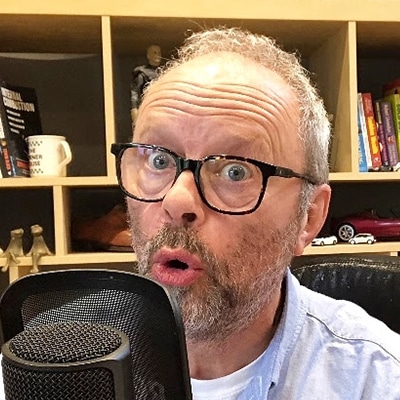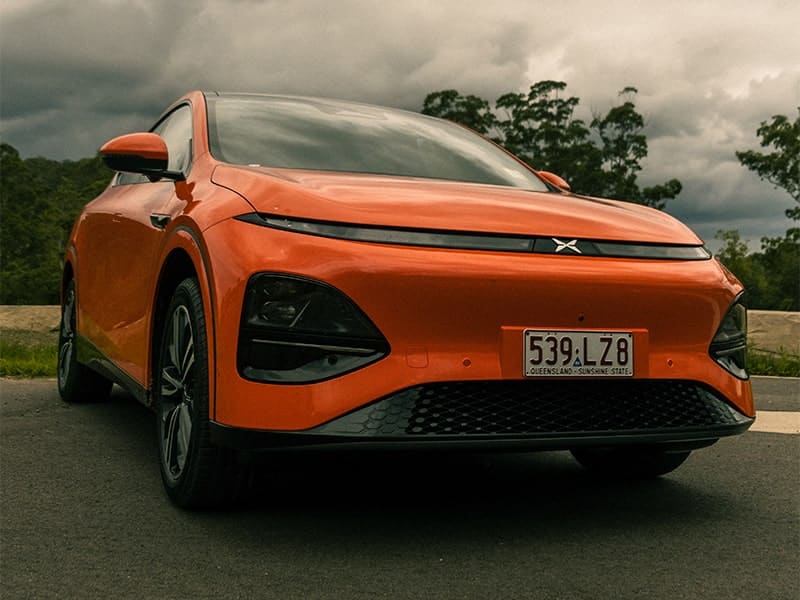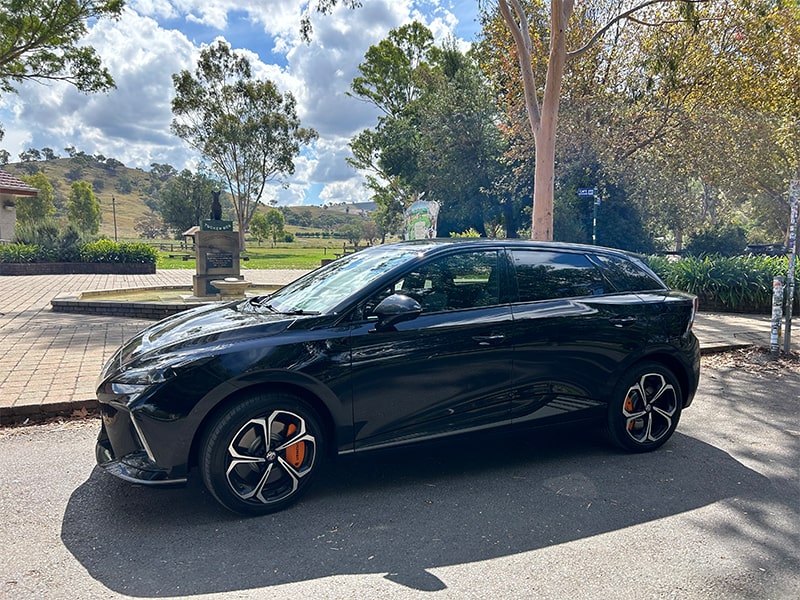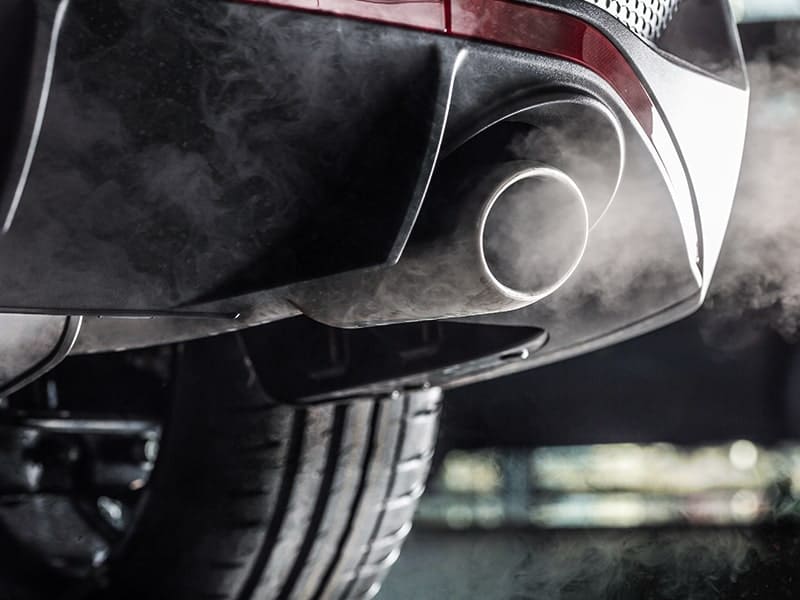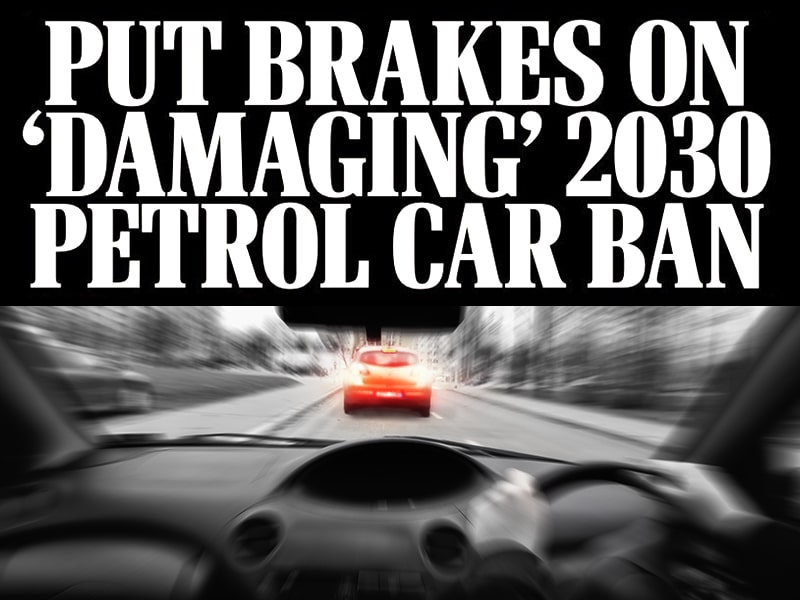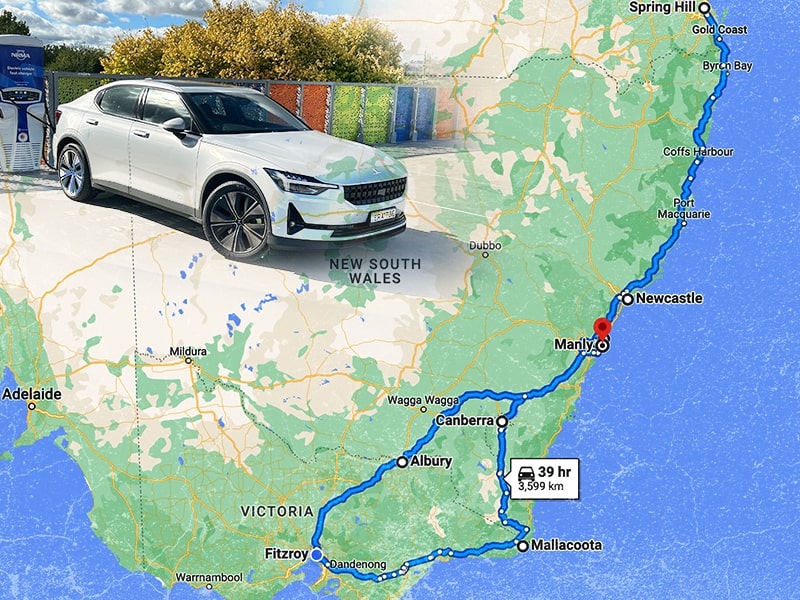
A week before my Australian wife Judy and I set off on our 3,500 kilometre road trip, we took possession of a brand spanking new Polestar 2, very generously loaned to us by Polestar in Australia.
And before I go any further, I am going to wax lyrical about this car, and if you want to think it’s because they loaned it to me that’s fine. But after driving it for many thousands of kilometres, I am going to state from the gut; the Polestar 2 is a very competent and beautifully put together machine.
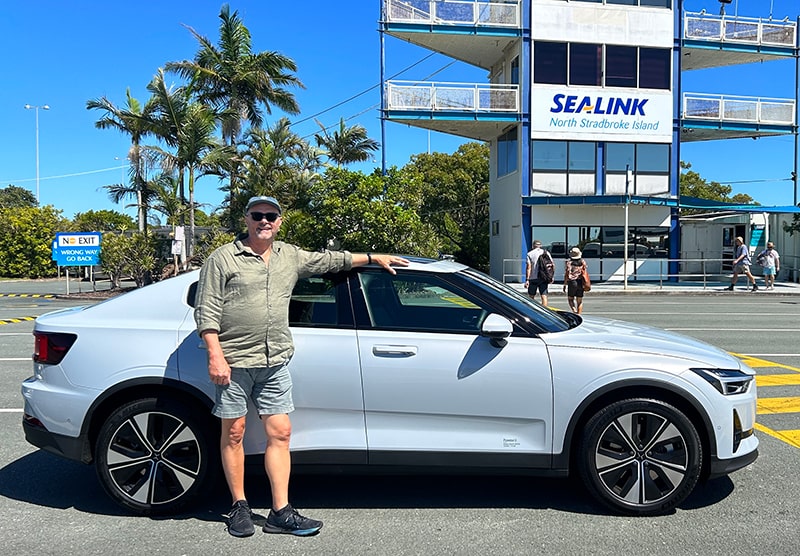
We had literally zero problems with the car, it went much further than I expected on one charge, very close to 420 kilometres or 260 miles with a comfortable buffer remaining.
We never drove it down or even near to 0% because we didn’t need to. There is enough very newly installed charging infrastructure to make any journey possible up and down the eastern seaboard of Australia.
One of the reasons I wanted to do this rather insane journey was to see what it was like to use the non Tesla charging infrastructure. 5 years ago during my last visit we drove a Tesla Model X from Sydney to Brisbane, using the supercharger network and it was just like driving a car a long way. We’ve all done it at some point, it’s mainly quite boring. Charging the car was an irrelevance it was so easy.
Using a car that relies on third party charging infrastructure is another matter as we all know. However an early frustration was nothing to do with the actual chargers or the car. It was the rather confusing app policy on iPhones. One of the apps I wanted to install was by Chargefox, who run a large network of Tritium rapid chargers in Australia.
I literally could not download the Chargefox app because I had a UK iPhone. I won’t bore you with the details but when I found this out I did do a a bit of wailing and gnashing of teeth. Okay, and some swearing and punching cushions. The byzantine frustration of not being able to buy electricity for electric cars like we buy diesel and petrol, or a sandwich, has created mental scar tissue which may never heal.
I contacted the Chargefox team and they were very helpful, they sent me an RFID card, delivered swiftly ℅ our friends in Sydney, but by the time I got my hands on the card, the app had been modified and I could install it. And I can now say with confidence, much as I dislike the whole app thing when it comes to car charging, the Chargefox app has worked faultlessly
But I have yet to see a rapid charger with a functioning touch to pay facility in Australia. Every other purchase I’ve made in the country has touch to pay, from a packet of crisps to a hotel bill. Easy peasy. All that is perfectly normal, but I have to download an app to charge a car. It still pains me.
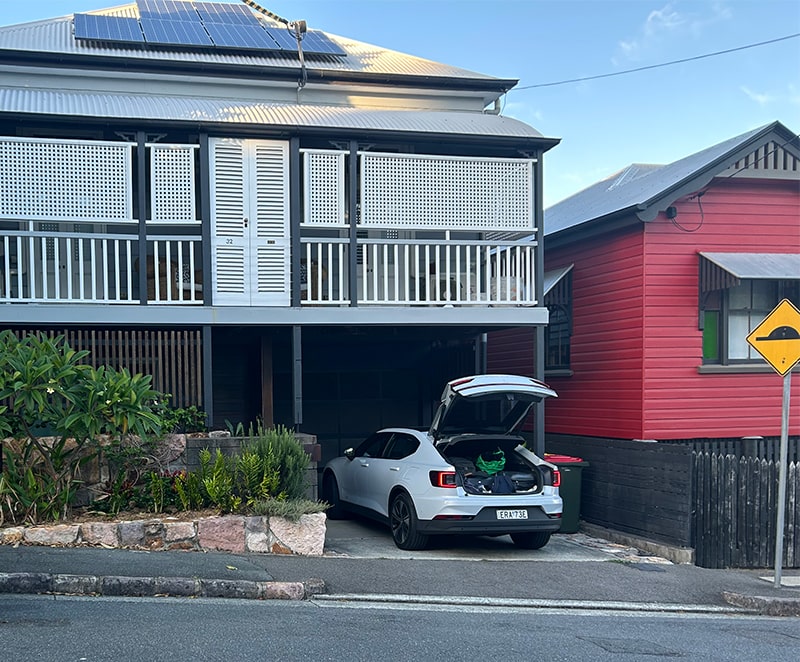
So, very early one morning, fully ‘apped,’ fully charged and fully prepped, we set off from our lovely Brisbane house swap home near where my wife Judy’s family reside. That first day we drove from Brisbane to Newcastle in New South Wales, a journey of 769 kilometres or 477 miles.
We did stop twice on that day, half to charge the car, and half because we needed a break for human reasons. It was fearsomely hot and bright, so a break from the long journey was a blessing. And this is a critical part of the argument about electric cars and long journeys.
I should mention how easy it was to find these chargers. I used the Plugshare app which is very comprehensive, so you do need to do a bit of forward planning. In a damn Tesla you just put in your final destination even if it’s 1,000’s of miles and it plots the entire route via Superchargers, informing you how long you need to charge at each one to get to the next. That might be as little as 10 or 15 minutes as you don’t always need to charge back to 100%.
Now, some long trip myths explored. I kept a very close eye on our average speed, not our top speed. Thankfully the Polestar records it very clearly.
We left a dense, urban area of central Brisbane, so obviously a lot of stop start and low speed travel, joining a busy highway after about 5 kilometres, we then drove at exactly the speed limit (100 kph) for hour after hour. Once we were in New South Wales that speed limit increased to 110 kph. However at the end of the day’s driving our average speed was 58 kph. Which basically means in three hours of driving, you only cover 174 kilometres.
Now there will be men reading this who will claim to drive 7 or 8 hours non stop in Australia, which is two things.
One, really incredibly dangerous, ask any Australian police officer. And two, incredibly bad for you. Please believe me when I say a bladder infection is no laughing matter. There will also be Australian men who drove 8 or even 10 hours non stop who are not reading this because they died in the attempt.
It is sadly quite a common occurrence for single occupancy cars to be found smashed into a tree on the side of the highway because the driver fell asleep. There are regular road signs warning of this and telling drivers to take a break.
Human beings need to stop and get out and walk and stretch and have a wee. About every 3 hours. So a car with a 500 plus kilometre range is totally unnecessary. 300 to 400 kilometres is super adequate.
That first day we used NRMA rapid chargers which worked without a hitch and are currently free to use. The NRMA (National Roads and Motorists’ Association Limited) operate many newly installed Tritium chargers in New South Wales.
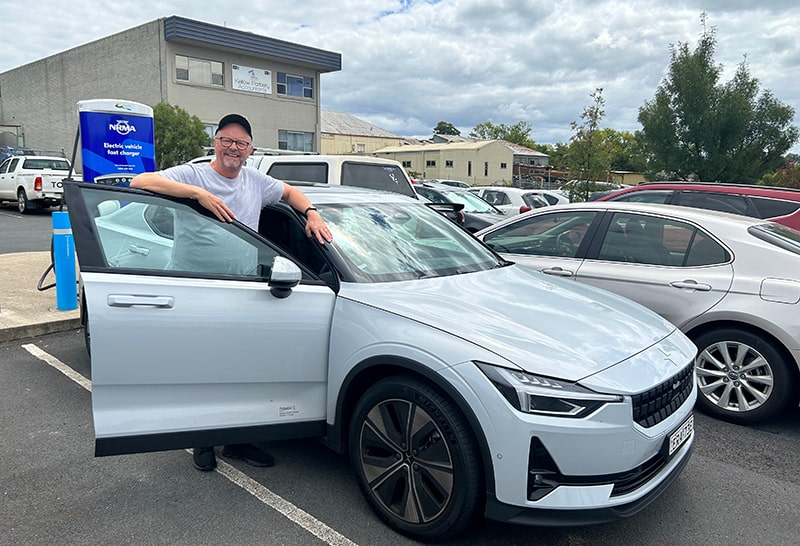
They became a firm favourite, but also the only time we had to wait because someone else was using the charger was when we stopped at an NRMA charger. They are very popular with the small but rapidly growing non Tesla EV community.
I should maybe quickly mention the impact Tesla have had in Australia, it is immense. Tesla Model 3 in particular are superabundant.
We stayed in a hotel in Central Newcastle that night, no destination charger, so the following day we set off for Canberra, a journey of a mere 436 kilometres. Stopping once to charge at a rest stop, this time using Chargefox app for the first time, which, after a bit of jiggery pokery worked perfectly.
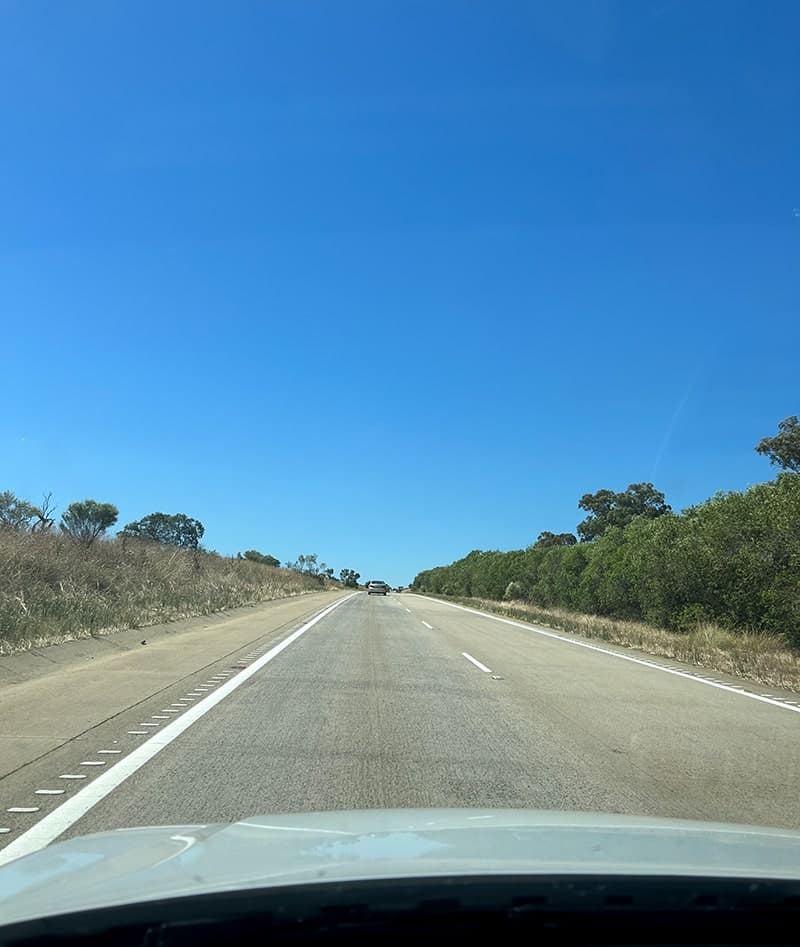
The following two nights we stayed in a hotel in Canberra while we caught up with old friends and my niece-in-law who had just had a baby. He’s a gorgeous little fella. We went to art galleries and walked around this very strange, but I have to say, very pleasant city.
And the reason we stayed in that particular hotel, they have destination chargers in the underground car park. So we set off the following day driving back up to Sydney, 327 kilometres, where we stayed with friends for 2 nights who let us charge the car from their extensive solar panels.
A quick sidebar about the levels of rooftop solar generation in Australia. It is now over a third of all Australian households and is the single largest contributor to the grid as a whole. More electricity is generated from solar than from digging up, transporting and burning coal.
We then drove to Bateman’s bay which is only 352 kilometres, but my wife wanted to visit the artist Arthur Boyd’s home which is just inland at Bundanon.
We arrived at the rather spectacular Bundanon Art Museum and low and behold, a row of Tesla destination chargers in the car park. So while we absorbed art and a very above average lunch, the Polestar absorbed about 35 kWh of free juice. (That’s about 140 -150 kilometres worth) Nice.
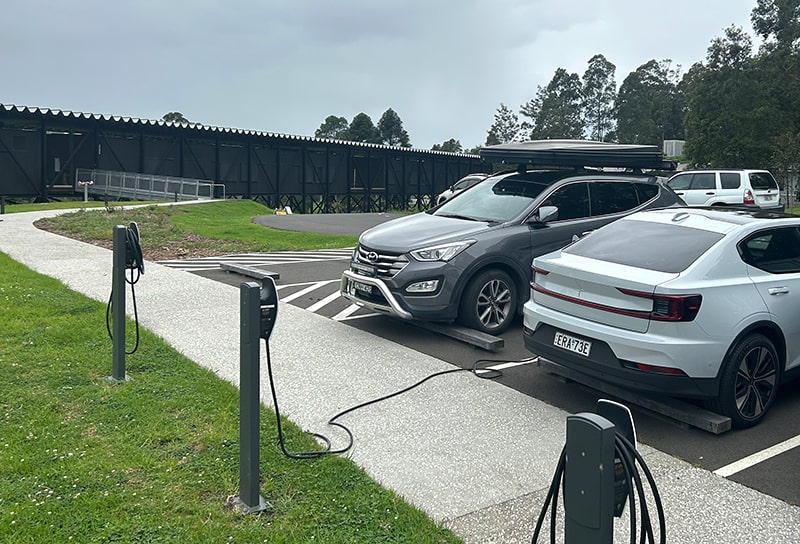
From there we drove down to Mallacoota on the coast of Victoria, a town that suffered badly from the raging bush fires of December 2019. We stayed at a small motel in the middle of the tiny coastal town. There was a rapid charger in stalled in a car park but it hadn’t been connected, but then saw that there was a destination charger we could use at ‘Dave’s house.’
So we rocked up and plugged in at Dave’s house, he ran an AirB&B but he also had a 22 kWh charger on the wall of his garage, with a large array of solar on his roof. I gave Dave $50 and we filled up that evening. Now this may seem a bit steep, but to be fair to Dave, it was massively convenient to us and he also gave us a jar of his truly beautiful honey.
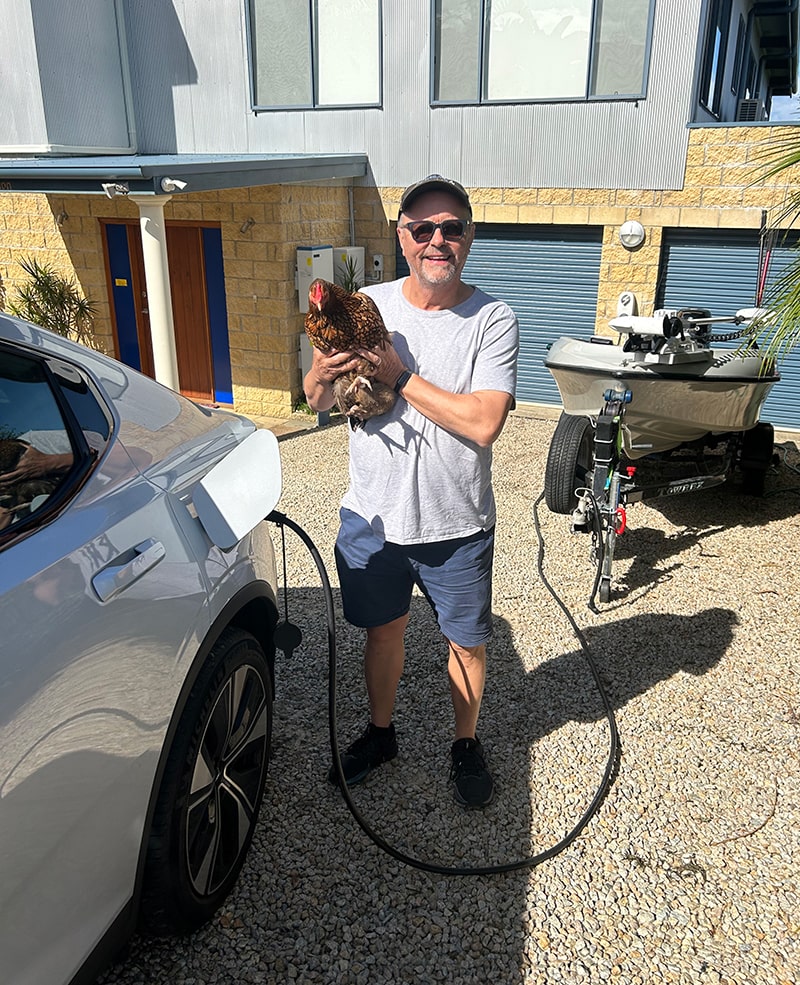
The following day we drove from Mallacoota to Fitzroy, stopping to charge at a lovely new Chargefox charger in Old Gippstown. We had a salad in a nearby cafe as it was brain meltingly hot that day, and after another long, long drive we arrived in Melbourne in the early evening.
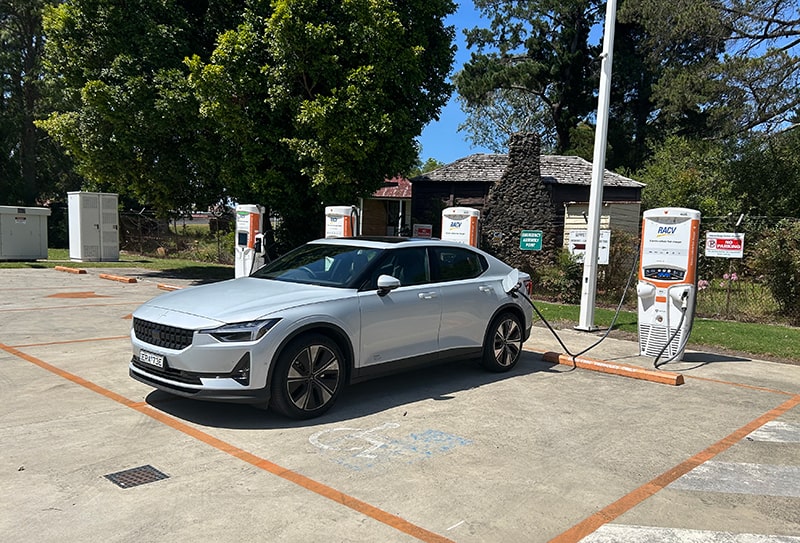
The difference between a boomer coastal hamlet in far east Victoria and downtown Fitzroy’s hipster Brunswick Street was fairly extreme but very welcome, Judy had lived in the area before we met, some 40 years ago.
We stayed in the city for 10 days, the car parked in the garage of the house swap apartment we lived in. We used one Chargefox charger in North Coburg while we were there, but to be honest we didn’t use the car much. (For locals who know the geography, we were visiting friends who lived nearby hence the choice.)
Melbourne has very good cycle lanes, an amazing tram network and is mostly very flat, so cycling and walking are easy. Not to ignore the fact that there are massive very busy freeways ripping through the city at various points, but cycling, scooters, public transport and walking are clearly very popular options.
Oh yes, and one more observation about Melbourne in particular and Australia in general. Motorbikes. I don’t know what the regulations are regarding exhaust noise, if there are any regulations they are studiously ignored by the rufty-tufty fella’s who roar upon and down on Melbourne’s streets. Unbelievably deafening. Is that really necessary chaps?
The last leg of our journey was from Melbourne back to Sydney and to be honest the mood was rather subdued. We’d had an amazing time, especially important for Judy as she caught up with dozen’s of friends and relatives she hadn’t seen in a long time due to global travel restrictions.
The journey from Melbourne to Sydney is 887 km or about 500 miles. We could have done it in one day but Judy has pals in Albury, on the border between Victoria and new South Wales, so after a 315 km (195 miles) we stopped there overnight.
In the morning we had breakfast at a sunny cafe with on friend of Judy’s while the car charged on a free to use NRMA charger on the roof of a totally empty car park.
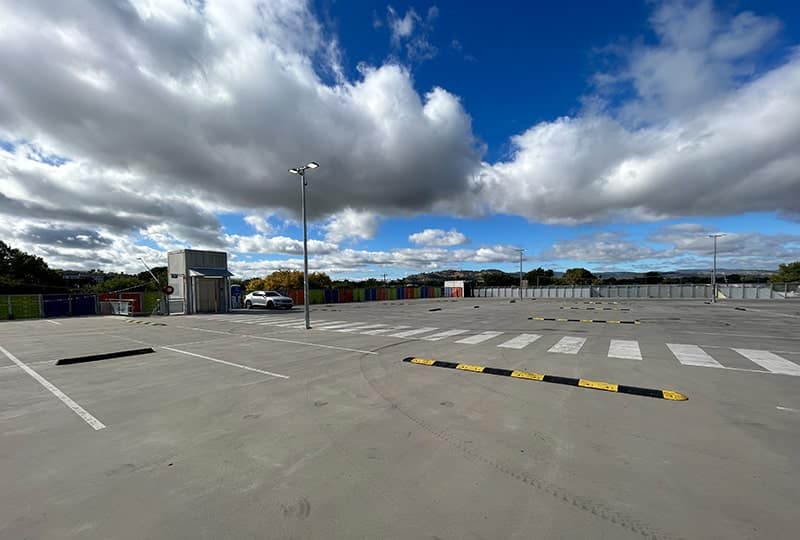
Once again we stopped for human reasons more than charging at a roadside services outside Gundagai. We used a 350 kW Chargefox charger although it put about 85 kW into the car. My main memory of this stop was the charger worked, the weather was hot and I needed a cold drink.
We arrived in Sydney just as it got dark and moved into our last house swap apartment this trip. I have to say, it’s not too scruffy. Overlooking the beach at Manly, one beautiful ferry ride straight into circular key and Sydney’s central business district, it’s hard not to describe this city as one of the most beautiful on the planet.
We then did some filming with the car before returning it to Polestar Australia.
So, some key points:
Driving 3,599 km (2,236 miles) is easily achievable in Australia with a still emerging charging system. We drove past dozens of sites where rapid chargers are being installed but not connected yet.
This is literally day one in terms of public charging infrastructure, it’s a start, the country needs tens of thousands more point. But what is here makes it very possible.
We did see plenty of Tesla superchargers on the trip and they are just now starting to open up for use by non Tesla vehicles.
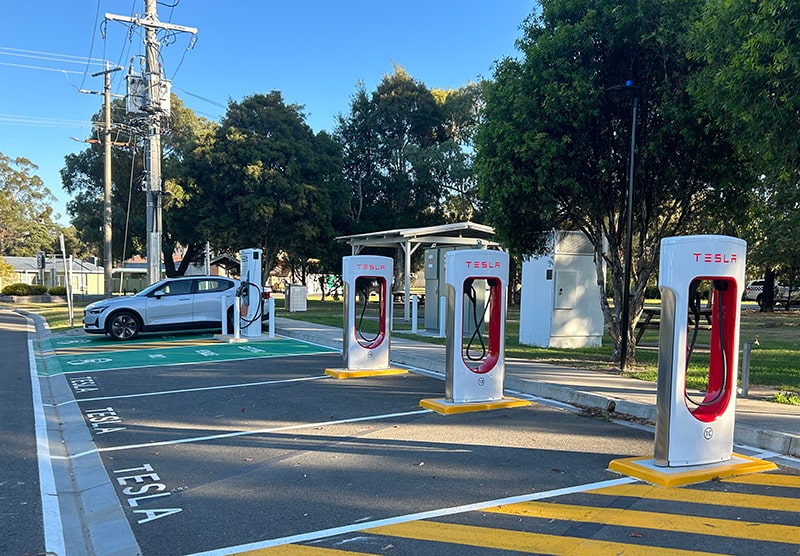
My only plea of the companies that install these chargers and any government department facilitating those installations is please, please make sure that maintenance is part of the contract.
We suffered for many years in the UK with installed but malfunctioning chargers and it’s heartbreaking. The amount of pictures of city dignitaries standing proudly next to a newly installed charger which, six month later, had broken down and wasn’t repaired is a travesty.
And also, a note to anyone reading this who hasn’t used an electric car. You don’t need rapid chargers like we relied on petrol and diesel pumps anything like as often as you might imagine. Yes, a long road trip is something people do in Australia every now and then, but not every day.
Charge a car when you’re not using it is the golden rule, slow charging is always a better option. Every car park space should have a socket, everywhere you can legally leave a car for a few hours needs a socket, every home should have a car charger socket.
One day they will, of that I have no doubt. And when people understand they can make their own ‘fuel’ for essentially zero cost, (rooftop solar) the idea of driving to a filling station, breathing in what genuinely is carcinogenic fumes, paying heaps of cash for toxic, imported fuel will seem utterly insane.
Now, the Polestar.
I say this now without fear or favour and written by someone who drives a Tesla Model 3.
The Polestar is a star, of that there is no doubt. The model we drove was single motor, rear wheel drive. 75 kWh battery, with a genuine range of over 400 kilometres. And what kilometres, it was such a delight to cover the distances we did in the car. The satnav uses Google maps and it works and it’s intuitive and simple to use.
The seats are comfortable for long drives, to baggage capacity is super ample, the manoeuvring cameras are genuinely helpful when reversing into a narrow garage or toward a rapid charger.
So at the end of this trip I’d like to genuinely acknowledge and thank the first nations people of Australia whose beautiful country we passed through.
And a very big thank you Polestar Australia, the NRMA, Plugshare, Chargefox, Evie and of course Dave in Mallacoota.
Oh, and my wife Judy who occasionally has to put up with me banging on about the vital role of renewables and electric ground transport that’s rapidly developing in this enormous, energy abundant country.




